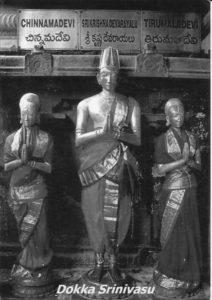The Splendid Grandeur of the Vijayanagara Empire
And now we can turn our focus towards the Vijayanagara Empire which was ruled by the four royal dynasties of Sangama, Saluva, Tuluva, and Aravidu. Among these, we can observe the fact that the Vijayanagara Empire had attained its zenith under the regime of the Sangama and Tuluva dynasties. The Vijayanagara Empire assumes significance due to its direct confrontation and fight against Muslim rulers. Till then, wars were being fought between Hindu kings. But this was the first time that a real battle began against Muslims in South India.
Harihara and Bukkaraya were the two prominent among the five sons of Sangama, a vassal of the Hoysalas. They belonged to the Halumata or the Kuruba clan. They founded the Vijayangara Empire under the inspiration and guidance of their Kulapurohita (the spiritual guide of their lineage), Sri Maadhavaacharya[i] (who later became a Yati and assumed the name, Vidyaranya). Findings from recent research in this area reveal that Queen Sriveerakekkaayi (wife of Ballala III) transferred the Hoysala royal power to her commander Sangama at Hosavuru or today’s Hospet.
In order to halt the march of Muslim raids and invasions, the Sangamas of Vijayanagara determinedly collected, developed, and strengthened resources required for the purpose. The collective will of the people in the whole of South India was fired up and forgetting all differences, laboured together for this common cause. However, this strength which had peaked during the Sangama period gradually weakened. The reason was the non-modernisation of its military force. Additionally, the decadent lifestyles of the successive generations contributed to slackening constant vigilance.
Of the five Sangama brothers, while Muddappa stood at the heart of the Empire and strengthened it, the other brother, Marappa shored up the coast. He was ably guided by the scholar of the Sastras and Astronomy and the author of a commentary on the Sutasamhita, the Minister named Angirasa Madhava. Under the leadership of Sayanacharya, the elder brother Kampana and his son Sangama II fortified the East Coast by making the Bhuvanagiri region in Andhra their centre of operations.
During the reign Harihara’s (or Hakka) younger brother Bukkaraya, who ascended the throne after the former’s demise, Vijayangara acquired even greater prosperity. Bukkaraya’s son, Kampana II (some people also call him Harihara II) liberated all the regions in South India suffering under Muslim atrocities and became the cause for the rejuvenation of Sanatana Dharma.
Devaraya I succeeded him. His son was the renowned Devaraya II or Proudha Devaraya, who was also decorated with the title, “Proudha Pratapi.” He successfully checked the external enemies who were few in number and further buttressed the borders and reinforced his naval force.
Proudha Devaraya revitalized the coast all the way up to Goa and built numerous ports and harbours. His military comprised fierce and able commanders like Lakkanna Dandesha. Proudha Devaraya also reinvigorated the entire Vijayanagara Empire in a mammoth overhaul exercise. Not just that. He gave extensive and generous patronage to art-literature-sastra and shone as a brilliant amalgam of Brahma and Kshatra.
Krishnadevaraya
Sri Krishnadevaraya is another extraordinary monarch of the Vijayanagara Empire. He never lost a single war that he waged against the kings of the Ganga, Gajapati and Bahamani dynasties. Even towards the end of his reign, the very mention of the name Sri Krishnadevaraya sent shivers of fear deep in the hearts of his enemies. Why, his enemies were scared of him even after his death. As Allasani Peddana writes in one of his Chatu-poems, in the immediate aftermath of Sri Krishnadevaraya’s death, the Bahamanis who embarked on a raid against Vijayanagara scampered far away in fear at the mere roar of a furious Vijayangara citizenry.
In a short span of his rule, Sri Krishnadevaraya had scaled Himalayan accomplishments. He was engaged in numerous battles for an extended period and held the record of not losing a single battle. He decisively vanquished the Bahamani Sultans in the fabled Battle of Raichur. Both his Hindu and non-Hindu enemies were mortally scared of the force of his valour.
Although Sri Krishnadevaraya maintained trade relations with the Portuguese for procuring warhorses and latest military equipment, he didn’t bother to develop this competence locally for some reason. Still, thanks to his outstanding military organisation, discipline, and use of the latest battle tactics, Sri Krishnadevaraya’s Kshatra and Timmarasu’s Brahma attained fruition. On one occasion, Sri Krishnadevaraya who set out on a military expedition returned after four years!
The Portuguese traveller, Nuniz has portrayed Sri Krishnadevaraya’s triumphant Raichur campaign in an arrestingly picturesque detail. Nuniz records that even after capturing the enemy fort, Sri Krishnadevaraya merely carted off firewood in girders—with the cooperation of the vanquished people—meant for his army’s fuel, and did not inflict any death, pain and loss upon them. This is a beautiful illustration of Sri Krishnadevaraya’s magnanimity and the brilliant resplendence of the Dharma innate in Bharata’s tradition of Kshatra.
Contrast this with the “extremely cultured and compassionate” Muslim king, Akbar’s sack of Chittorgarh during which he plundered the entire city, burned it down and committed a barbaric genocide of innocent citizens. This is a brutal fact proudly recorded by his court poet, Abul Fazl. There exist several such comparative studies in regard to the Kshatra spirt of Hindu kings and its barbaric Islamic counterpart; indeed, more such comparative studies are waiting to be written. And despite this brutality, Akbar became “Akbar the great,” an epithet that still eludes Sri Krishnadevaraya. This is a cruel irony of history.
Sri Krishnadevaraya’s greatest weakness was his attachment towards his son, a fact revealed by recent research. Dr. Gopalakrishna who has conducted a thorough and in-depth research about Sri Krishnadevaraya avers that his son Tirumalaraya was a premature baby. The child was coronated right in his boyhood. The rumours that the minister Timmarasu administered poison to the boy have all turned out to be untrue. The death of his son killed all enthusiasm for life within a Sri Krishnadevaraya who had developed blind attachment for him. Timmarasu’s conviction was clear: “a king who ascends the throne must be endowed with all-round, undiluted competence. In this, the question of bloodline or royal lineage doesn’t arise at all.” However, kings are intrinsically imbued with a desire to see their own bloodline seated on the throne. And so, it is here that we see the difference between a Kshatra only by the accident of birth and one which is endowed with true Kshatra in spirit, temperament and deed.
At a certain point in his magnum opus, AmuktamAlyada, Sri Krishnadevaraya writes: “a Kshatriya must never be appointed to the position of a Minister or Commander. If such an appointment is made, there is always a lingering possibility that such a person will dispose the king and occupy his throne someday.” The truth or otherwise of this statement apart, it is certainly not a healthy sign for the Hindu society.
Owing to the depression emanating from his son’s death, Sri Krishnadevaraya passed away in his middle age when he was just over fifty.
Idol of Krishnadevaraya and his wives at Tirupati
During the course of his regime and amidst numerous pressures, he attained superlative political and cultural accomplishments. He was himself a Vidwan of the highest order. His well-known works include AmuktamAlyada, SakalakathAsArasaMgraha, and MadAlasacaritrachampU among others. He was an accomplished poet in both Sanskrit and Telugu, and provided constant and generous patronage to poets and pandits.
And then, today, there is this untrue clamour that Sri Krishnadevaraya heaped injustice upon Kannada. There’s absolutely no historical evidence to back this claim. Sri Vyasaraya who was the cynosure of the Haridasa Movement was seated on the Vijayanagara throne by Sri Krishnadevaraya himself—this incident is recorded in the Vyasayogicarita (literally, “History of the Yogi, Sri Vyasa”). His reverence extended in equal measure to both Purandaradasa and Kanakadasa. Indeed, for absolute renunciates like these Haridasas, of what use is material help? And so, this royal reverence was one of the suitable methods of honouring them. In the precincts of the Sri Venkateswara Deity at Tirupati, the words “Sri Krishnadevarayaru” are inscribed in the Kannada script. In fact, the contribution of Sri Krishnadevaraya to the Haridasa Movement is immeasurable. When he launched an expedition against Srikakulam, the Andhra Mahavishnu appeared in his dream and addressed him as “Kannada Raya” (The Monarch of the Kannada Country)—a fact that Sri Krishnadevaraya himself records (AmuktamAlyada:1-14). He also had the title, “KannadaramAramaNa.” A majority of his royal inscriptions are written in Kannada. He bestowed a very high position upon the really average Kannada poet, Timmanna, author of the Krishnadevaraya Mahabharata. Although he was personally a devout Bhakta of Vishnu, he built the Rajagopurams of the Virupaksha and Kalahasti Temples.
Sectarian fanaticism and linguistic hatred of any sort didn’t exist in the Vijayanagara Era. A key element that one observes when examining the tradition of Bharata’s Kshatra is the rarity of cultural tumults and hostilities. When we consider any major era, although there was paucity of strategy and tactics, there was absolutely no shortage of magnanimity, ethics, and affection. However, predatory faiths and prophetic creeds never noticed any of this much less respected it.
Translated by Hari Ravikumar and Sandeep Balakrishna



















































